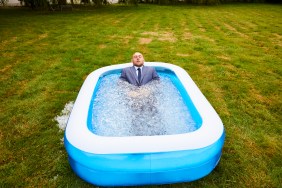We’ve all been there. You’re lying in bed exhausted yet unable to fall asleep. Sleeping next to your smartphone, stress, caffeine…we all know the obvious factors that contribute to sleepless nights. But before you reach for the Ambien, read on to learn how to fall asleep fast with some proven sleep aid techniques that just may help you achieve that elusive state of slumber.
4-7-8 Breathing Exercise
Based on Pranayama, an ancient Indian practice, this exercise has been popularized by Dr. Weil (who rose to stardom thanks to Oprah and has written countless books). The technique is designed to ease the body into relaxation in five quick steps. Weil recommends sitting with your back straight while learning the exercise and placing the tip of your tongue against the ridge of tissue just behind your upper front teeth. “Keep it there through the entire exercise. You will be exhaling through your mouth around your tongue. Try pursing your lips slightly if this seems awkward,” he says.
Then exhale completely through your mouth, making a whoosh sound. Close your mouth and inhale quietly through your nose to a mental count of four. Hold your breath for a count of seven. Exhale completely through your mouth, making a whoosh sound to a count of eight. This is one breath. Now inhale again and repeat the cycle three more times for a total of four breaths. According to Weil, the process of holding your breath in allows oxygen to fill your lungs and circulate throughout your body, which has a calming effect.
Progressive Relaxation
As soon as you get into bed, “curl your toes tightly for a count of seven, and then relax. Repeat through each muscle group, working up from your toes to your neck,” recommends Catherine Darley, ND, director of the Institute of Naturopathic Sleep Medicine in Seattle.
Sleep with Someone
This one may be easier said than done, but a number of studies have found that sharing a bed with a partner promotes more restful sleep. A 2009 study, for example, found that women in long-term, stable relationships fell asleep quicker and woke up less often during the night compared to single women or women who had lost or gained a partner during the six- to eight-year period of the study. The theory is that sleeping with a partner promotes “feelings of safety and security leading to lower levels of the stress hormone cortisol, lower levels in cytokines that can cause inflammation, and higher levels of the so-called love hormone, oxytocin, which has been shown to ease anxiety and is produced in the same part of the brain responsible for the sleep-wake cycle.” Further, “the psychological benefits we get having closeness at night trump the objective costs of sleeping with a partner.”
Move
The experts at the National Sleep Foundation recommend that if you get into bed and can’t sleep after 20 minutes, you should get up and do a relaxing activity (reading, listening to music) somewhere else in your home. “Lying in bed awake can create an unhealthy link between your sleeping environment and wakefulness. Instead, you want your bed to conjure sleepy thoughts and feelings only.”
Relaxation Exercise
To implement this technique for how to fall asleep fast developed by the National Sleep Foundation, start by softening your muscles and focusing your attention on your body. Notice if your mind begins to wander and bring it back to your body. Take note of where you feel your breath in your body and focus your attention on the full breath, from start to finish. Take a deep breath into your lower belly and feel your abdomen expand with air. Hold this for a few seconds and then release. Notice your belly rising and falling. Continue to do this for a few minutes, remembering to refocus your attention every time your mind starts to wander. Take note, from head to toe, of anywhere you feel tension and try to release that tension. As you do this, direct your breath into that area of your body to help release that tension. Then continue to focus on your breath, picturing it flowing in and out of your belly.
Get Cold Feet
When we’re sleeping or starting to fall asleep, our body temperature naturally drops, reaching its lowest when we are in a deep sleep. Feet help regulate heat loss and maintain a lower temperature, which is why simply placing one or both feet outside of the blanket may ease you into a sleepy state. Experts have also determined that the ideal room temperature for sleep is between a comfortable 60 to 67 degrees Fahrenheit. Studies have also found that “wearing socks dilates your blood vessels and can help blood flow, leading to a more optimal temperature for snoozing,” so cover up those feet before you stick them out.
[ Next: Why Am I So Tired? Experts Weigh In ]








